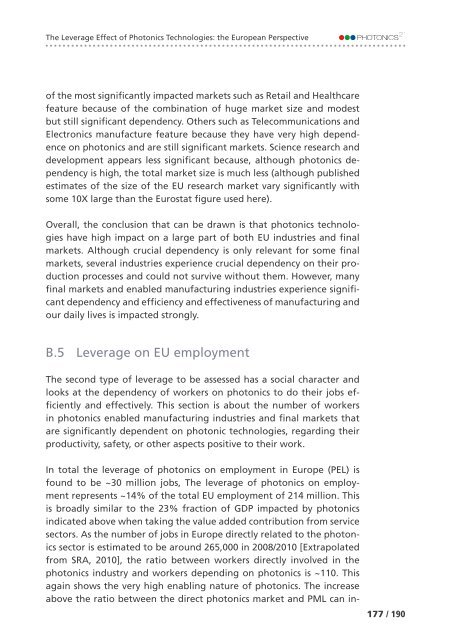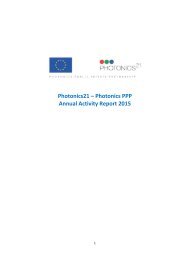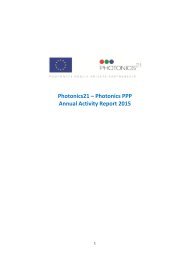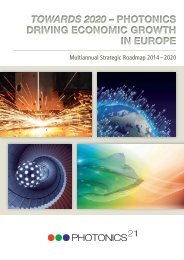of Photonics Technologies: the European Perspective The Leverage Effect
Create successful ePaper yourself
Turn your PDF publications into a flip-book with our unique Google optimized e-Paper software.
<strong>The</strong> <strong>Leverage</strong> <strong>Effect</strong> <strong>of</strong> <strong>Photonics</strong> <strong>Technologies</strong>: <strong>the</strong> <strong>European</strong> <strong>Perspective</strong><br />
<strong>of</strong> <strong>the</strong> most significantly impacted markets such as Retail and Healthcare<br />
feature because <strong>of</strong> <strong>the</strong> combination <strong>of</strong> huge market size and modest<br />
but still significant dependency. O<strong>the</strong>rs such as Telecommunications and<br />
Electronics manufacture feature because <strong>the</strong>y have very high dependence<br />
on photonics and are still significant markets. Science research and<br />
development appears less significant because, although photonics dependency<br />
is high, <strong>the</strong> total market size is much less (although published<br />
estimates <strong>of</strong> <strong>the</strong> size <strong>of</strong> <strong>the</strong> EU research market vary significantly with<br />
some 10X large than <strong>the</strong> Eurostat figure used here).<br />
Overall, <strong>the</strong> conclusion that can be drawn is that photonics technologies<br />
have high impact on a large part <strong>of</strong> both EU industries and final<br />
markets. Although crucial dependency is only relevant for some final<br />
markets, several industries experience crucial dependency on <strong>the</strong>ir production<br />
processes and could not survive without <strong>the</strong>m. However, many<br />
final markets and enabled manufacturing industries experience significant<br />
dependency and efficiency and effectiveness <strong>of</strong> manufacturing and<br />
our daily lives is impacted strongly.<br />
B.5 <strong>Leverage</strong> on EU employment<br />
<strong>The</strong> second type <strong>of</strong> leverage to be assessed has a social character and<br />
looks at <strong>the</strong> dependency <strong>of</strong> workers on photonics to do <strong>the</strong>ir jobs efficiently<br />
and effectively. This section is about <strong>the</strong> number <strong>of</strong> workers<br />
in photonics enabled manufacturing industries and final markets that<br />
are significantly dependent on photonic technologies, regarding <strong>the</strong>ir<br />
productivity, safety, or o<strong>the</strong>r aspects positive to <strong>the</strong>ir work.<br />
In total <strong>the</strong> leverage <strong>of</strong> photonics on employment in Europe (PEL) is<br />
found to be ~30 million jobs, <strong>The</strong> leverage <strong>of</strong> photonics on employment<br />
represents ~14% <strong>of</strong> <strong>the</strong> total EU employment <strong>of</strong> 214 million. This<br />
is broadly similar to <strong>the</strong> 23% fraction <strong>of</strong> GDP impacted by photonics<br />
indicated above when taking <strong>the</strong> value added contribution from service<br />
sectors. As <strong>the</strong> number <strong>of</strong> jobs in Europe directly related to <strong>the</strong> photonics<br />
sector is estimated to be around 265,000 in 2008/2010 [Extrapolated<br />
from SRA, 2010], <strong>the</strong> ratio between workers directly involved in <strong>the</strong><br />
photonics industry and workers depending on photonics is ~110. This<br />
again shows <strong>the</strong> very high enabling nature <strong>of</strong> photonics. <strong>The</strong> increase<br />
above <strong>the</strong> ratio between <strong>the</strong> direct photonics market and PML can in-<br />
177 / 190






